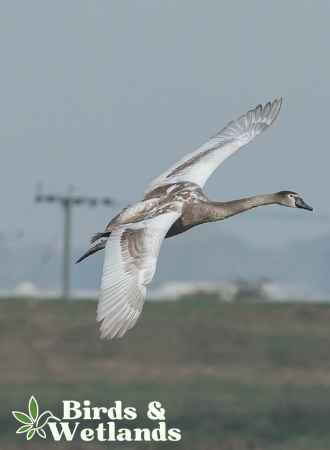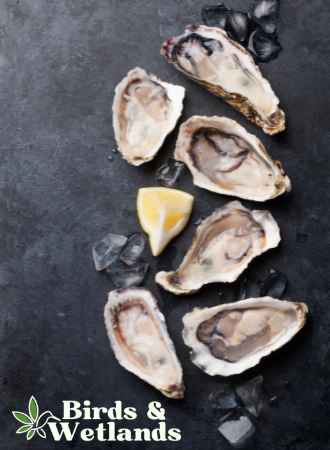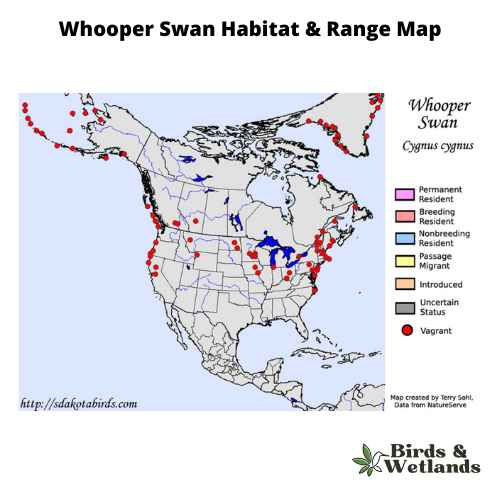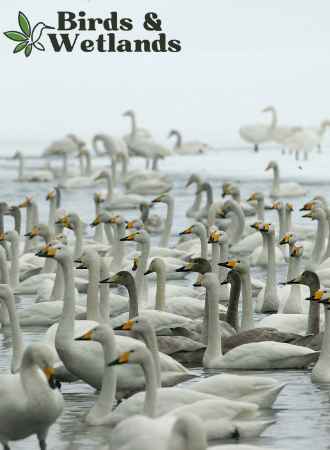The whooper swan, pronounced hooper swan, is a large waterbird native to the northern hemisphere. It is a closely relative of the shorter-necked Bewick swans. In some parts of the world, they are called the common swan.
The whooper swan is a migratory species and breeds in the Arctic tundra of Europe and Asia and winters in more temperate regions of Europe, Asia, and North America.
Whooper swans are known to be quite vocal birds and can be heard from quite a distance away. They are also known for their beautiful, graceful flight and are a popular sight on many lakes and shallow rivers.
Whooper Swan Description
The adult whooper swan is a beautiful, large bird with a majestic appearance. It has a striking white plumage overall, but some birds may have a hint of rufous wash on the head and neck due to the mineral-rich waters where they feed.
Their bill has orange-yellow beak markings and tipped with black. Their eyes are deep dark brown, and their long neck makes them appear elegant and graceful. The legs of adult whooper swans are black with webbed feet, enabling them to swim in swift and effortless movements.
Their wingspan ranges between 205-275 cm, making them one of the largest flying birds in Europe. They weigh approximately 7-10 kgs, with males slightly heavier than females. A wintering male swan in Denmark weighed 15 kgs.
Their feathers are densely packed together, providing excellent insulation against the cold winter months. When they take flight, they beat their wings powerfully as they soar high into the sky before gracefully gliding back down again.
Juveniles have gray brown feathers with white underparts and a black-tipped beak.
Despite their huge size, the whooper swans are powerful fliers. These birds are largely migratory and travel hundreds or thousands of miles annually to their wintering grounds.
Compared to other swans, the whooper swan is larger than the Bewick’s swan but smaller than the trumpeter swan.

Listen to the Whooper Swan
Whoopers are known for their signature whooping calls, pre-flight signals and wing flapping.
Whooper Swan Diet
The whooper swan is a waterfowl native to Asia, Europe, and North America that is omnivorous. It primarily feeds on aquatic vegetation such as sedges, pondweeds, and algae but also consumes grasses, grains, potatoes, acorns, and other plant matter.
Additionally, the whooper swan eats small insects, mollusks, fish, and other invertebrates.
With its long neck, the whooper swan can forage for food in wetlands and shallow bodies of water. To find adequate food year-round, the whooper swan migrates between seasonal habitats.
During the summer, many whooper swans can be found in marshlands, while in autumn, these birds take advantage of grain fields in rural areas. Dominant birds spend more time feeding in these areas than submissive birds.
When food is scarce in winter, whooper swans seek out protected coastal waters with abundant aquatic plants and invertebrates.

Whooper Swan Habitat
The whooper swan prefers to live in marshes, forested regions with shallow waters, slow-flowing rivers and protected coastal flats. Freshwater lakes with long shorelines are potential breeding sites for these birds.
In the winter, most whooper swans stay in low-lying farmlands along the coasts. Some flocks favor locations with lots of vegetation for food and land cover, such as river banks or forests.
Smaller flocks of whooper swans have been observed inland, foraging in agricultural fields for waste grains, crops and grasses.
Whooper Swan Range & Population
The whooper swan is a large northern hemisphere swan that breeds in the taiga regions of Iceland, Scandinavia, and Eurosiberia. During the nesting season, these swans can be found in freshwater marshes, lakes, rivers, and coastal areas. The Icelandic whooper swan population is relatively stable.
During the winter months, migratory populations of whooper swans migrate to western and central Europe and the Baltics. Some flocks of whooper swans may venture farther than their range and reach the areas surrounding the Black, Aral and Caspian seas.
However, some swans have been observed to migrate late in the winter which resulted in whooper swans freezing to death.
These whooper swans are often seen with Bewick’s swans and can be found on freshwater marshes, ponds, rivers, and on coastal lagoons and sheltered estuaries. They can also be seen waterfowl grazing in agricultural fields.
The eastern Siberia whooper swan population winters in coastal regions of China, Korea, and Japan.
Occasionally, migrating whooper swans fly to their wintering sites in the Aleutian Islands and many nearby islands and western North America. These individuals are likely from the eastern Siberian population and may have strayed from their normal migration routes.
Some flocks overwinter in their wintering range. Many wild whooper swans decide to stay in their wintering grounds even if its time for their spring migration.

Whooper Swan Reproduction & Mating System
Whooper swans form breeding pairs in late winter and early spring. Males are known for their elaborate courtship displays. Before attacking, competing swans outstretch their wings.
These swans begin breeding in April and June. It is noteworthy, that not all pairs lay eggs.
During the nesting season, breeding pairs generally choose a nesting site on the ground near water. They prefer to nest in pairs but may also nest in loose colonies.
Nesting sites are often chosen for their proximity to food sources and protection from predators. Nesting materials are gathered from nearby vegetation, such as grasses and reeds, and used to construct the nest.
Female whooper swans will lay an average of four to seven eggs during the breeding season. The female incubates the eggs for approximately 30 to 34 days. The male stands guard nearby for the entire incubation period.
Once the eggs hatch, the cygnets will leave the nest within a few days. The parents helps cygnets feed and teach them to swim and find food. Parents don’t carry newborn cygnets on their backs unlike their close relatives, the trumpeter swans.
Cygnets rarely initiate flight and will stay with their parents until they are fully fledged. Chicks begin to fledge between August and September. After becoming fully fledged, the young swans will leave the nest and begin their independent lives.
Predation by known predators arctic foxes, golden eagles, hooded crows, snapping turtles, wild boars, California gulls, North American river otters, great-horned owls, white-tailed eagles and brown bears are the leading causes of cygnets death.

Whooper Swan Conservation Status
The whooper swan is are not a threatened species and currently classified as Least Concern by the International Union for Conservation of Nature (IUCN). This means that these birds’ population is considered stable and not at risk of extinction in the near future. This classification is primarily due to the species’ large range and high population.
However, egg poaching, habitat loss, pollution, destruction of food sources, and climate change threaten whooper swans.
Habitat degradation and destruction of food sources can directly reduce the available resources for the whooper swans, making it harder for them to survive. Climate change can also impact the birds by altering the timing of their migration, which can affect their breeding and survival.
In addition to these threats, these swans also face predation from natural predators such as foxes, raccoons, and birds of prey. While predation alone is not typically a significant threat to the population of these swans, it can negatively impact individual birds’ reproductive success. This means that predation can contribute to the decline of the population over time.
To protect the population of these swans, it is important to address these threats and work to conserve their habitats and food sources. Fortunately, environmental protections are in place in some parts of the world. There are laws that make hunting swans illegal in Russia and China.

Key Takeaways
- Whooper swans breed in taiga and tundra regions of Eurosiberia.
- Whooper swan nests are made from plant materials and lined with down feathers.
- Whooper swans feed on plants and small animals.
- The breeding season begins in April.
- Whooper swan pairs nest on the ground, near the water.


